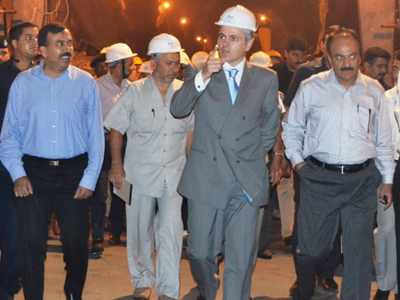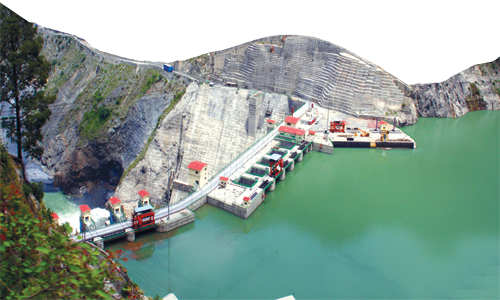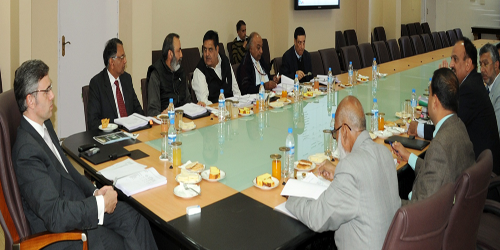J&K state-owned profit-earning Power Development Corporation is awarding five projects to independent power producers, two of them state subjects, to add 131 MW to its kitty. It will lead to an investment of Rs 1048 crore in some of the remote belts of the state. R S Gull offers details of the projects and the companies that would implement them.

After making corrections in the state’s power policy especially for the smaller projects to be implemented through the independent power producers (IPP), the State Power Development Corporation (SPDC) started the process of implementing 10 projects. In the first stage, it was to seek a request for qualification (RFQ) to assess the interested companies. There were 61 proposals for 10 projects. However, when they were assessed on various parameters, 25 bidders failed to meet qualification criteria.
Five of the ten projects in which less than three parties showed their interest were not processed as it was decided by the SPDC board that they would be re-tendered. In the second stage, SPDC sought RFQ from the qualifiers for the five projects only. As the proposals were submitted, the consultant, PricewaterhouseCoopers (PwC), started evaluating the bids. After a series of evaluations envisaging studying non-financial bids and seeking clarifications on various issues, 17 bids were finally opened in September. The bids were evaluated for three parameters – free power that the SPDC would get, the terminal price of the project at the end of the 35 years when the state will take over it and finally, the levelled tariff at which the IPP would sell its generation to the SPDC.
The final exercise was to evaluate the Net Present Value (NPV) for the project computed on the basis of the basic parameters to offer the total net outflow for the actual owner, the SPDC. The higher the value, the costlier the deal. Companies whose financial bids offered a higher negative value became the L1, the successful bidder. The orders for the five allotments stand approved already and are being formally issued to the successful bidders this week. Here is a brief profile of the projects and the companies that would be implementing them across the state.
45 MW BICHLARI PROJECT
Bagged by M/S DIPL Netcom Power Consortium, a state subject, for an NPV of Rs 61.16 crore, the SPDC would get 15.01 per cent free power. At the time of its transfer to the SPDC after 35 years, the IPP would also pay Rs 1 crore to the corporation. Levellized tariff that was computed on the basis of tariff stream quoted by bidders over 35 years would be Rs 2.89 per unit of energy that the SPDC would purchase. All bidders have to ink the power purchase agreement with the SPDC under the new IPP policy as there is no flexibility of having any other buyer.
Bichilari is a spot around 20 km from Ramban where the local rivulet, a tributary of Chenab, joins it at Harsala village. The project envisages harnessing the rivulet to produce 45 MW of clean energy. It envisages a weir (with a water level of 1290 meters) across the rivulet just downstream of the confluence point at Banihal and Mahumangat nallah, and a surface powerhouse with three units of 15 MW each near Digdol village, almost 8.76 km downstream of the diversion structure on its left bank.
An 8.76 km long head race D-shaped tunnel would take 10.78 cubic meters per second of water and pass through 2.2-meter diameter penstocks to feed three vertical axis Pelton turbines working under a rated head of 462.6 meters. After generating power, a 150-meter tail race channel would return water to the river. The project would require around 25 hectares of land including around five hectares of forest land. To be ready within the next five years, the project would cost around Rs 360 crore at the current price level.
Officials in the SPDC said that given the submergence level of the proposed 695 MW Sawalkote project, there is a possibility of increasing the Bichlari’s power potential. This, however, would require a new study that might suggest extending the tunnel by a few kilometres and relocating the power station. Right now, however, that is no priority.
40 MW ANS PROJECT
Of the five contenders, bids by one company were rejected for crippling technical reasons. From the remaining three, the bid by M/S Sri Avantika Consortium was evaluated as the best one. Its NPV was evaluated to be Rs -7.88 crore. It was based on the offers that apart from offering 15% of generation as royalty, and a levellized tariff of Rs 1.04 per unit for 35 years, the IPP would return the project to the state for only one crore rupees after the deal period was completed.
The project that is designated to generate 220 million units of energy is a run-of-the-river scheme being set up at Thilloo village of Reasi, around 150 km from Jammu. Ans is a local rivulet that is a tributary of Chenab. The project envisages diverting the rivulet to a barrage at Nadoli and feeding a powerhouse downstream at Thillo. Water will be taken from an 876-meter barrage through an 8 km, D-shaped, RCC tunnel with a four-meter diameter having a capacity of 27.08 meters. It will be a single penstock branching down into four falling for a total height of 4070 meters to move four horizontal axes Francis turbines to generate 10 MW each. To be ready within the next five years, the project would cost around Rs 320 crore.
Ans is Chenab’s major perennial tributary that drains around 1090 sq km for 77 km between its rise and confluence with Gulabgarh Nallah. It is joined by three small rivulets on its right banks on the length on which the alignment is planned. These include Shikari nallah, Dabri nallah and Kalar nallah.
27 MW KANZIL WANGATH
Four companies gave their financial bids for setting up this project in the Kangan belt of Kashmir and it was again M/S DIPL Netcom Power Consortium that bagged the contract as its bid was evaluated at an NPV of Rs 4.72 crore, the lowest of all. Apart from offering 15.25% of free power as royalty, it would sell energy at a levellized price of Rs 1.44 per unit. SPDC would get the project back after 35 years and would pay one crore rupees to the corporation at the termination of the deal. Though other companies had offered to return the project for free and offer more free power but they were making more money by making the energy sales to the SPDC very expensive.
With a yearly design of generating 104 million units a year, the project would cost Rs 216 crore. It would be a run-of-the-river scheme with its headworks at Kanzil village, upstream of Naranag, about 4 km from Wangath. The power station will be in Wangath itself. This stream originating from Gangbal from a height of 4575 meters above mean sea level is a tributary of the Sindh rivulet that is otherwise feeding three projects – Sumbal, Kangan and Ganderbal. Its average discharge is 13.50 cubic meters per second (cms) which falls to one cms in winter.
The project envisages a power canal feeding the forebay where from the water will be dropped through an 1100-meter-long penstock for feeding three units at a net head of 245 meters. Instead of a tunnel, the project would have an open canal linking the right bank of the stream between Kanzil and Wangat villages. It will drain from an RCC weir and divert 15.84 cumecs of water to the project. The project would use three vertical Francis turbines to deliver a power of 9 MW each. Though the area lacks any wildlife sanctuary but the forest cover exists. The population is scattered and mostly falls below the poverty line.
12 MW GIRJAN KI GALI PROJECT
For this project in Poonch, there were four bidders. It was finally bagged by M/S Raheja Power Ventures Pvt. Ltd after its parameters were evaluated at the lowest NPV of Rs -23.16 crore. The company would offer 15% of its generations free to the state and hand over the project back to the state plus Rs 272.70 crore as a terminal offering, not price. Its tariffs would be decided by the SERC as per the existing policy in vogue. All the small projects under 25 MW through IPP mode will have their tariffs decided by the SERC.
First of its project in the Pir Panchal region, it would use the waters from Parnai nallah and will be located in an area around 20 km from Surankote (Poonch), in the foothills of Ratan Pir range (towards Bafliaz and Suran Valley). Parnai Nallah is a major tributary of the Suran River. This rivulet originates at the Western slopes of the Pir Panchal range and eventually joins Jhelum through the Suran River after crossing the LoC. The project will be located in Girjan village and would use around 10.64 cms of water to feed four units of horizontal Axis Francis turbines – two units of 4 MW each and two units of 2 MW each. The length of the main penstock will be 300 m which will bifurcate near the powerhouse into four branches, two of 1100 mm diameter and two of 800 mm diameter, to feed four independent turbines.
The project envisages diverting Parnai River inflows by the construction of a diversion structure. It will have a three km long cut and cover an 11.70 cms capacity water conductor using the left bank of the river that will feed 1900 mm diameter penstock to feed the turbines. The weir will be set up in Lachho Da Pahad village.
At an estimated cost of Rs 96 crore, the project is designed to generate 55.14 million units of energy in a year. The power station will be in Chandimarh village on the Mughal road near Bahram Gala. The environment may not have a major impact because the population is sparse and most of the area is hilly. Most of the barrage will be located on the riverbed itself. The area adjacent to the project site has coniferous forests, mainly Deodar Pine, Fir and Kail.
7 MW Chananwari Project
Uri near LoC has remained a powerhouse for the NHPC. While Uri-I is functional for more than a decade, Uri-II will go into generation by the end of 2013. SPDC has finally decided to get into the border town with this project under IPP mode in Chandanwari.
There were two bidders for this project bagged by M/S Nazir Hussain Khan as its offering parameters were evaluated by PwC to an NPV of Rs – 17.13 crore, the lowest. While this new company will offer 21% of its generation as free power, it will return the project to the SPDC after 35 years free and no terminal price. As the project falls under the sub-25 MW category, its per-unit tariffs will be evaluated by the SERC later.
The project would use the discharge from Bijhama Nallah that originates from the mountain ranges of Qazinagh Springs from an altitude of about 4000 m. It has a perennial flow with a peak discharge of 5.61 cms and drains into Jhelum near Noorkhan. Its headworks would be set up at Naloosa village as the power station would be set up at Noorkhan hamlet. The project will have three vertical-axis Francis Turbines of 2.33 MW, each designed to generate 41.95 million units of energy a year. Tentatively, it would cost Rs 56 crore.
The water will be diverted into a low-level crated weir and taken through a 1769 m power canal with a capacity to drain 4.94c cms into a forebay. A 12-mm-thick penstock with a fall of 440 meters would trifurcate to feed three turbines. The project would be accessible from Mohra, the heritage project of the state currently under serious consideration for revival.
A Good Beginning
The SPDC had offered bidders that the corporation would purchase the projects back after 35 years at a cost not more than 10 per cent of the actual DPR costs. Interestingly, however, all the bidders made offers that they would pay from their side to the corporation after 35 years were completed. In Poonch project would require an overall investment of Rs 96 crore, for instance, it would fetch SPDC Rs 227 crore and the project.
“We have put in a mechanism that the developer will have to deposit amount regularly with one of our banks accounts so that it equals Rs 227.70 crore when 35 years complete,” MD, SPDC, Basharat Ahmad said. “It has been a good restart,” Basharat said the SPDC is in the process of tendering out another 13 small projects under IPP and 11 of them are exclusively for state subjects. The corporation is planning a gala event with the state investors to encourage them to get into the energy sector.

















